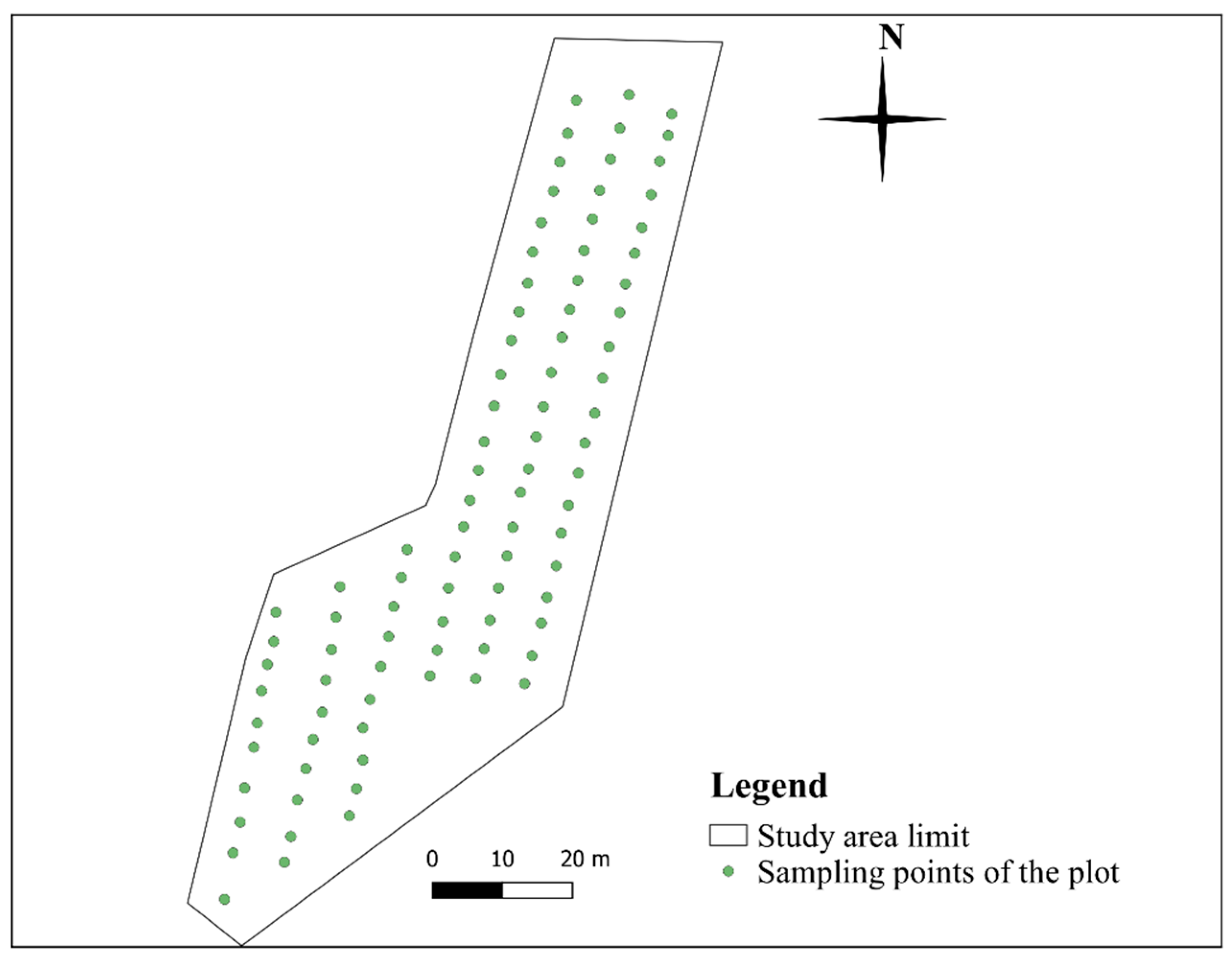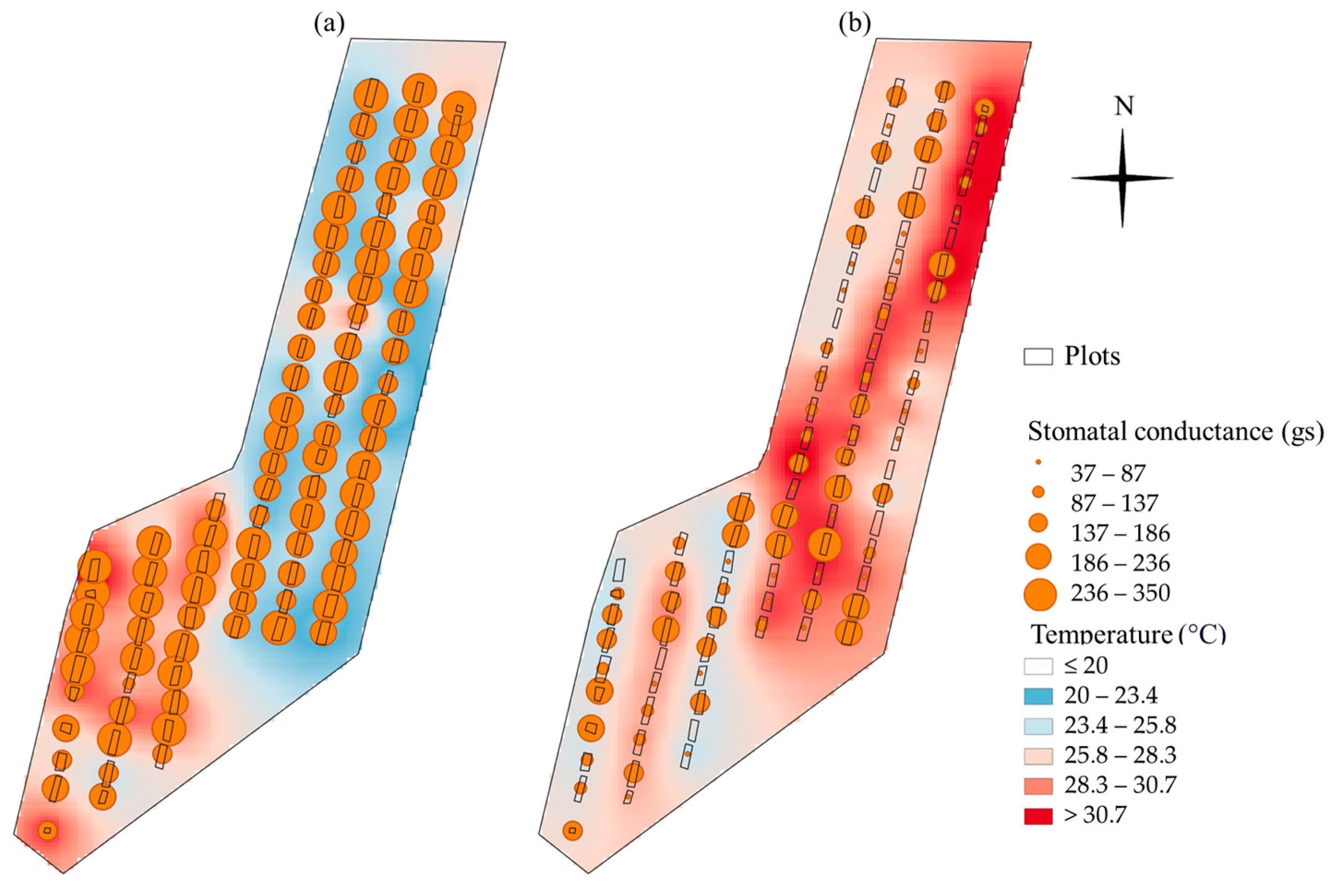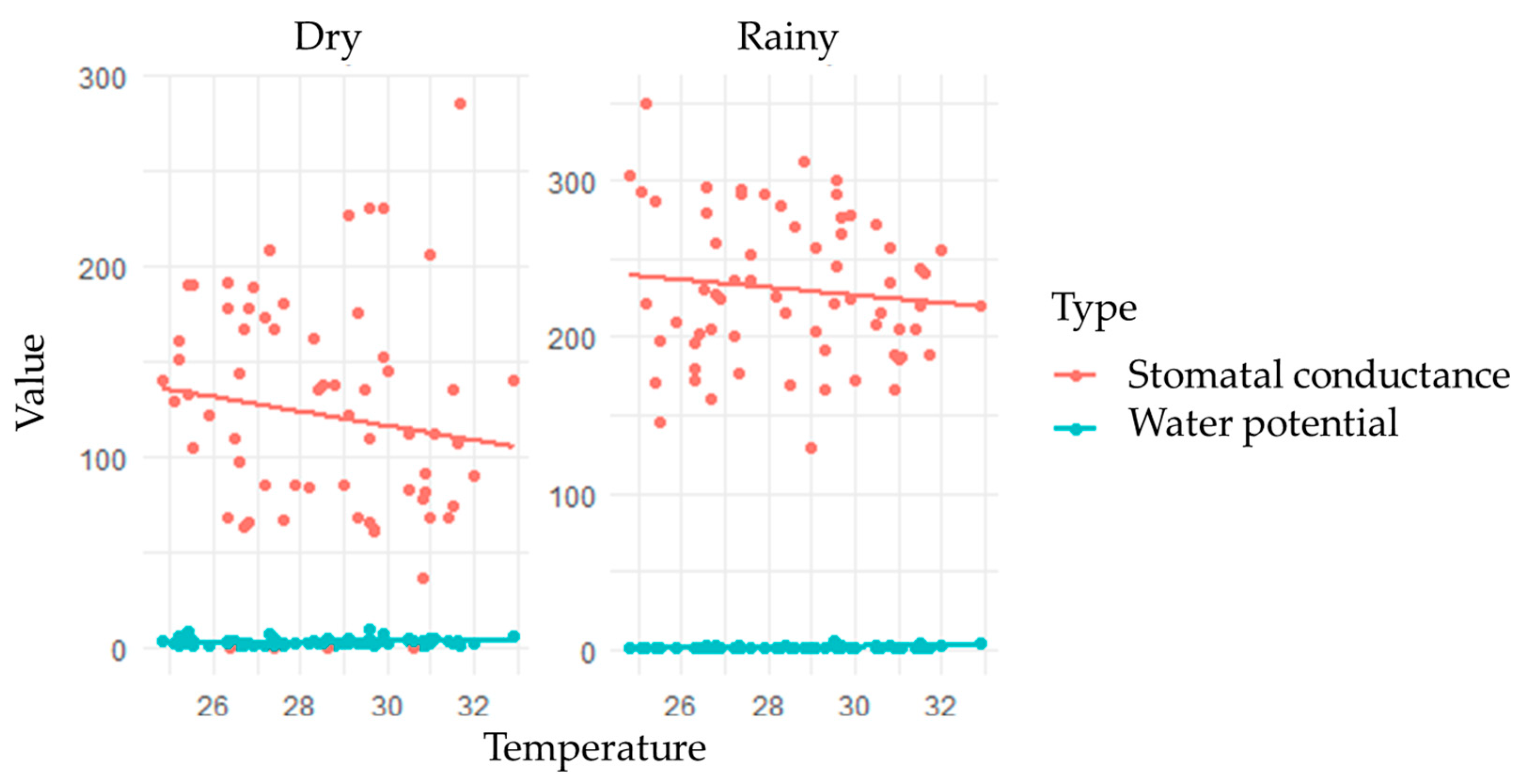A Spatial Analysis of Coffee Plant Temperature and Its Relationship with Water Potential and Stomatal Conductance Using a Thermal Camera Embedded in a Remotely Piloted Aircraft
Abstract
1. Introduction
2. Materials and Methods
2.1. Study Location
2.2. Measurements of the Physiological Response
2.3. RPA Data Collection
2.4. Meteorological Data
2.5. Analysis and Validation of the Models
3. Results
3.1. Geostatistical Analysis
3.2. Correlation Analysis between Temperature, gs, and WP
4. Discussion
5. Conclusions
Author Contributions
Funding
Data Availability Statement
Acknowledgments
Conflicts of Interest
References
- United States Department of Agriculture (USDA). Available online: https://fas.usda.gov/sites/default/files/2024-06/coffee.pdf (accessed on 25 July 2024).
- Companhia Nacional de Abastecimento (CONAB). Available online: https://www.conab.gov.br/info-agro/safras/cafe (accessed on 25 July 2024).
- Voltolini, G.B.; da Silva, L.C.; de Oliveira Alecrim, A.; Castanheira, D.T.; Resende, L.S.; Rezende, T.T.; Guimarães, R.J. Soil chemical attributes in coffee growing with different agronomic techniques. Coffee Sci. 2020, 15, e151689. [Google Scholar] [CrossRef]
- DaMatta, F.M.; Ramalho, J.D.C. Impacts of drought and temperature stress on coffee physiology and production: A review. Braz. J. Plant Physiol. 2006, 18, 55–81. [Google Scholar] [CrossRef]
- Castanheira, D.T.; Barcelos, T.R.; Guimarães, R.J.; Carvalho, M.A.D.F.; Rezende, T.T.; Bastos, I.D.S.; Cruvinel, A.H. Agronomic techniques for mitigating the effects of water restriction on coffee crops. Coffee Sci. 2019, 14, 104–115. [Google Scholar] [CrossRef]
- Peloso, A.D.F.; Tatagiba, S.D.; Reis, E.F.D.; Pezzopane, J.E.M.; Amaral, J.F.T.D. Photosynthetic Limitations in Leaves of Arabic Coffee Promoted by the Water Deficit. Coffee Sci. 2007, 12, 389–399. Available online: http://www.coffeescience.ufla.br/index.php/Coffeescience/article/view/1314 (accessed on 6 May 2023). [CrossRef]
- Almeida, V.G.; Sousa, C.M.; dos Santos, S.G.F.; Sarti, J.K.; da Silva, D.P.; Pereira, W. Gas exchange of coffee trees (Coffea arabica) at hight temperatures in the Cerrado of Goiás. Res. Soc. Dev. 2020, 9, e4779119973. [Google Scholar] [CrossRef]
- Cavatte, P.C.; Oliveira, Á.A.; Morais, L.E.; Martins, S.C.; Sanglard, L.M.; DaMatta, F.M. Could shading reduce the negative impacts of drought on coffee? A morphophysiological analysis. Physiol. Plant. 2012, 144, 111–122. [Google Scholar] [CrossRef]
- Santos, L.M.; Ferraz, G.A.S.; Alves, H.J.P.; Rodrigues, J.D.P.; Camiciottoli, S.; Conti, L.; Rossi, G. Comparison of spatial-temporal analysis modelling with purely spatial analysis modelling using temperature data obtained by remote sensing. Agron. Res. 2021, 19, 1423–1435. [Google Scholar] [CrossRef]
- Santos, S.A.D.; Ferraz, G.A.E.S.; Figueiredo, V.C.; Volpato, M.M.L.; Machado, M.L.; Silva, V.A. Evaluation of the water conditions in coffee plantations using RPA. AgriEngineering 2022, 5, 65–84. [Google Scholar] [CrossRef]
- Crusiol, L.; Nanni, M.; Furlanetto, R.; Sibaldelli, R.; Mertz-Henning, L.M.; Nepomuceno, A.; Farias, J. NDVI e Imagem Termal Obtidos por Vant Aplicados ao Monitoramento da Condição Hídrica da Cultura da soja. In Congresso Brasileiro de Soja, 8; Inovação, Tecnologias Digitais e Sustentabilidade Da Soja: Goiânia, Brazil; Embrapa: Anais, Brazil, 2018; Available online: https://ainfo.cnptia.embrapa.br/digital/bitstream/item/179614/1/NDVI-e-imagem-p.p.296-298.pdf (accessed on 6 May 2023).
- Santos, C.S.D.; Freitas, A.F.D.; Silva, G.H.B.D.; Carvalho, M.A.D.F.; Santos, M.D.O.; Carvalho, G.R.; Silva, V.A. Adaptations to the drought season and impacts on the yield of ‘Híbrido de Timor’ coffee tree in the Minas Gerais State Cerrado (Brazilian Savanna). Pesqui. Agropecuária Trop. 2022, 52, e72448. [Google Scholar] [CrossRef]
- Viana, L.A.; Zambolim, L.; Sousa, T.V.; Tomaz, D.C. Potential use of thermal camera coupled in uav for culture monitoring. Rev. Bras. Eng. Biossistemas 2018, 12, 286–298. [Google Scholar] [CrossRef]
- Alecrim, A.O.; Castanheira, D.T.; Voltolini, G.B.; Netto, P.M.; Guimarães, R.J.; Gonçalves, A.H. Phytosociology of weeds in coffee plants with different soil management techniques. Sci. Agrar. Parana. 2020, 19, 270–279. [Google Scholar] [CrossRef]
- FLIR Duo R Datasheet. Available online: https://www.flir.com.br/support/products/duo/#Documents (accessed on 19 September 2024).
- Vieira, S.R.J.L.; Hatfield, J.; Nielsen, D.; Biggar, J. Geostatistical theory and application to variability of some agronomical properties. Hilgardia 1983, 51, 1–75. [Google Scholar] [CrossRef]
- Oliver, M.A.; Webster, R. A tutorial guide to geostatistics: Computing and modelling variograms and kriging. Catena 2014, 113, 56–69. [Google Scholar] [CrossRef]
- Mendes, A.; dos Santos, G.R.; Emiliano, P.C.; Kaleita, A.L.; de Paula Ferreira, M. Estimation of The Sampling Size of Geostatistics Considering Gaussian Variogram Model in the Presence of Outliers. Energ. Na Agric. 2019, 34, 429–440. [Google Scholar] [CrossRef]
- Ferreira, I.O.; Santos, G.D.; Rodrigues, D.D. Study on the use Appropriate of the Kriging in the Computational Representation of Surfaces Bathymetric. Rev. Bras. Cartogr. 2013, 65, 831–842. Available online: https://seer.ufu.br/index.php/revistabrasileiracartografia/article/view/43864/23128 (accessed on 6 May 2023).
- Isaaks, E.H.; Srivastava, R.M. An Introduction to Applied Geostatistics; Oxford University Press: New York, NY, USA, 1989; p. 561. [Google Scholar]
- Ferraz, G.A.S.; Silva, F.M.D.; Carvalho, L.C.; Alves, M.D.C.; Franco, B.C. Spatial and temporal variability of phosphorus, potassium and of the yield of a coffee field. Eng. Agrícola 2012, 32, 140–150. [Google Scholar] [CrossRef][Green Version]
- Santos, L.M.; Ferraz, G.A.; Batista, M.L.; Martins, F.; Barbosa, B.D. Characterization of noise emitted by a low-profile tractor and its influence on the health of rural workers. An. Acad. Bras. Ciências 2020, 92, e20200460. [Google Scholar] [CrossRef]
- Silva, M.A.J.G.; Ferraz, P.F.P.; Santos, L.M.D.; Rossi, G.; Barbari, M. Effect of the Spatial Distribution of the Temperature and Humidity Index in a New Zealand White Rabbit House on Respiratory Frequency and Ear Surface Temperature. Animals 2021, 11, 1657. [Google Scholar] [CrossRef]
- Cambardella, C.A.; Moorman, T.B.; Novak, J.M.; Parkin, T.B.; Karlen, D.L.; Turco, R.F.; Konopka, A.E. Field-scale variability of soil properties in central Iowa soils. Soil Sci. Soc. Am. J. 1994, 58, 1501–1511. [Google Scholar] [CrossRef]
- Ribeiro, P.J., Jr.; Diggle, P.J. geoR: A package for geostatistical analysis. R News 2001, 1, 14–18. [Google Scholar]
- Ferraz, P.F.P.; Ferraz, G.A.; Moura, R.S.D.; Cecchin, D.; Silva, D.R.D.; Cadavid, V.G. Thermal comfort in rabbit shed on days with and without rain. Rev. Bras. Cunicult. 2020, 17, 7–17. [Google Scholar] [CrossRef]
- Faraco, M.A.; Uribe-Opazo, M.A.; Silva, E.A.A.D.; Johann, J.A.; Borssoi, J.A. Selection criteria of spatial variability models used in thematical maps of soil physical attributes and soybean yield. Rev. Bras. Ciência Solo 2008, 32, 463–476. [Google Scholar] [CrossRef]
- Gomes, F.P.; Garcia, C.H. Statistics Applied to Agronomic and Forestry Experiments: Presentation with Examples and Guidelines for the Use of Applications; FEALQ: Piracicaba, Brazil, 2002; p. 309. [Google Scholar]
- Steppuhhn, H. Pre-irrigation of a severely-saline soil weth in-situ water to establish dryland forages. Trans. ASAE 2001, 44, 1543–1551. [Google Scholar] [CrossRef]
- Bergonci, J.I.; Bergamaschi, H.; Rosa, L.M.G.; Santos, A.O. Leaf conductance as an indicator of water deficit in maize. Rev. Bras. De Agrometeorol. 2000, 8, 27–34. [Google Scholar]
- Cornic, G.; Ghashghaie, J.; Genty, B.; Briantais, J.M. Leaf photosynthesis is resistant to a mild drought stress. Photosynthetica 1992, 27, 295–309. [Google Scholar]
- Pacheco, F.; Lazzarini, L.E.; Alvarenga, I. Metabolism Related To Stomatic Physiology. Enciclopédia Biosf. 2021, 18, 186–206. [Google Scholar] [CrossRef]
- Costa, G.F.D.; Marenco, R.A. Photosynthesis, stomatal conductance and leaf water potential in crabwood (Carapa guianensis). Acta Amaz. 2007, 37, 229–234. [Google Scholar] [CrossRef]
- Dominghetti, A.W.; Souza, A.J.D.J.; Silveira, H.R.D.O.; Sant’Ana, J.A.D.V.; Souza, K.R.D.D.; Guimarães, R.J.; Lacerda, J.R. Tolerance to drought of coffee trees produced by cuttings and somatic embryogenesis. Coffee Sci. 2016, 11, 117–126. [Google Scholar]
- Haworth, M.; Marino, G.; Brunetti, C.; Killi, D.; De Carlo, A.; Centritto, M. The impact of heat stress and water deficit on the photosynthetic and stomatal physiology of olive (Olea europaea L.)—A case study of the 2017 heat wave. Plants 2018, 7, 76. [Google Scholar] [CrossRef]
- Callegari-Jacques, S.M. Biostatistics: Principles and Applications; Artmed: Porto Alegre, Brazil, 2008; 255p. [Google Scholar]
- Stojcsics, D.; Lovas, I.; Domozi, Z.; Molnar, A. High resolution 3D thermal imaging using FLIR DUO R sensor. In Proceedings of the 2018 IEEE 22nd International Conference on Intelligent Engineering Systems (INES), Las Palmas de Gran Canaria, Spain, 21–23 June 2018; pp. 000311–000316. [Google Scholar] [CrossRef]






| Day | C0 | C1 | C0 + C1 | a (m) | DSD | ME | SDME | RE | SDRE | |
|---|---|---|---|---|---|---|---|---|---|---|
| 26 November 2019 | 0.64 | 5.66 | 6.29 | 9.50 | 90% | strong | −0.02 | 1.19 | −0.01 | 1.00 |
| 8 November 2020 | 2.06 | 6.27 | 8.34 | 9.69 | 75% | moderate | 0.02 | 1.95 | 0.00 | 1.02 |
Disclaimer/Publisher’s Note: The statements, opinions and data contained in all publications are solely those of the individual author(s) and contributor(s) and not of MDPI and/or the editor(s). MDPI and/or the editor(s) disclaim responsibility for any injury to people or property resulting from any ideas, methods, instructions or products referred to in the content. |
© 2024 by the authors. Licensee MDPI, Basel, Switzerland. This article is an open access article distributed under the terms and conditions of the Creative Commons Attribution (CC BY) license (https://creativecommons.org/licenses/by/4.0/).
Share and Cite
Santos, L.M.d.; Ferraz, G.A.e.S.; Carvalho, M.A.d.F.; Campos, A.A.V.; Neto, P.M.; Xavier, L.A.G.; Mattia, A.; Becciolini, V.; Rossi, G. A Spatial Analysis of Coffee Plant Temperature and Its Relationship with Water Potential and Stomatal Conductance Using a Thermal Camera Embedded in a Remotely Piloted Aircraft. Agronomy 2024, 14, 2414. https://doi.org/10.3390/agronomy14102414
Santos LMd, Ferraz GAeS, Carvalho MAdF, Campos AAV, Neto PM, Xavier LAG, Mattia A, Becciolini V, Rossi G. A Spatial Analysis of Coffee Plant Temperature and Its Relationship with Water Potential and Stomatal Conductance Using a Thermal Camera Embedded in a Remotely Piloted Aircraft. Agronomy. 2024; 14(10):2414. https://doi.org/10.3390/agronomy14102414
Chicago/Turabian StyleSantos, Luana Mendes dos, Gabriel Araújo e Silva Ferraz, Milene Alves de Figueiredo Carvalho, Alisson André Vicente Campos, Pedro Menicucci Neto, Letícia Aparecida Gonçalves Xavier, Alessio Mattia, Valentina Becciolini, and Giuseppe Rossi. 2024. "A Spatial Analysis of Coffee Plant Temperature and Its Relationship with Water Potential and Stomatal Conductance Using a Thermal Camera Embedded in a Remotely Piloted Aircraft" Agronomy 14, no. 10: 2414. https://doi.org/10.3390/agronomy14102414
APA StyleSantos, L. M. d., Ferraz, G. A. e. S., Carvalho, M. A. d. F., Campos, A. A. V., Neto, P. M., Xavier, L. A. G., Mattia, A., Becciolini, V., & Rossi, G. (2024). A Spatial Analysis of Coffee Plant Temperature and Its Relationship with Water Potential and Stomatal Conductance Using a Thermal Camera Embedded in a Remotely Piloted Aircraft. Agronomy, 14(10), 2414. https://doi.org/10.3390/agronomy14102414









